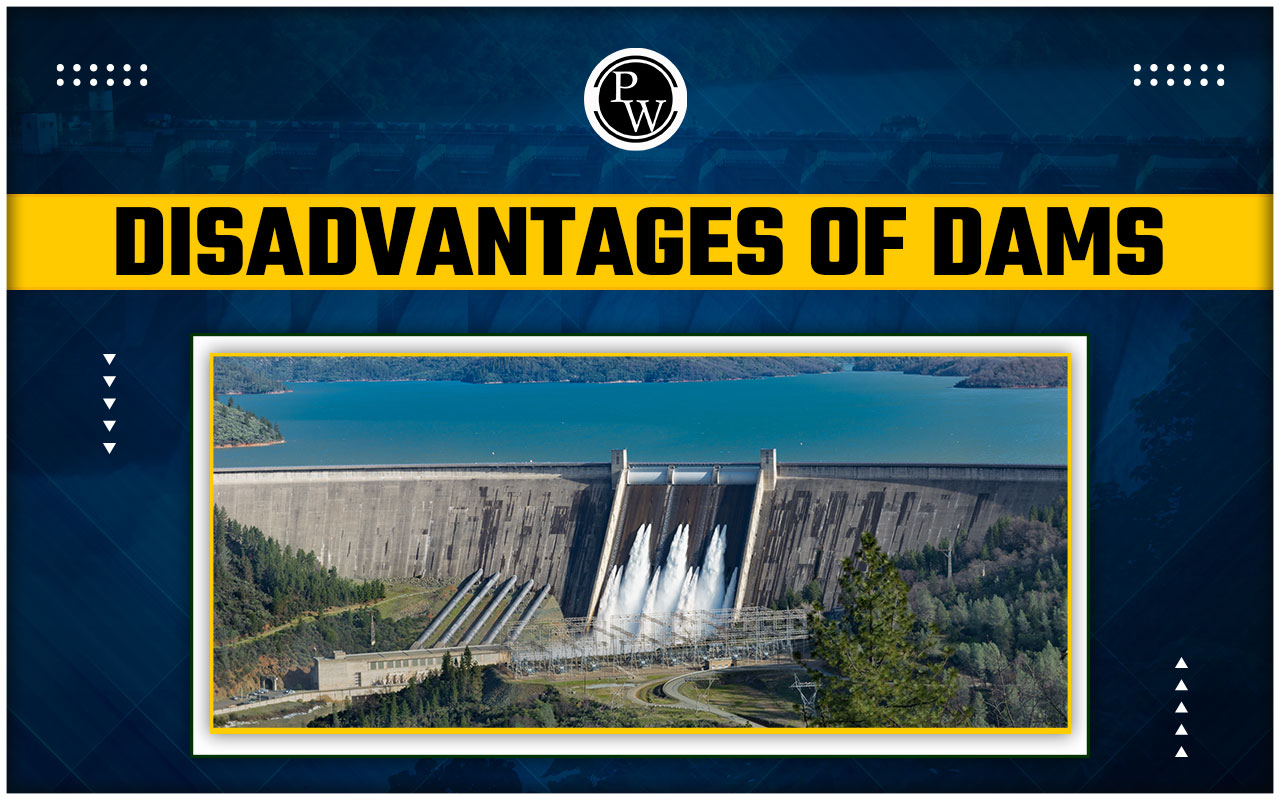

If you are looking for the Disadvantages of Dams, you have come to the right place!
The topic “Disadvantages of Dams” will be covered in this article. Dams are necessary for storing and supplying the population with enough water. Dams are required to provide the water needed for domestic, industrial, and agricultural use. One of the most crucial goals of dam construction is hydroelectric power generation. In addition to serving our standard requirements, they are significant tourist destinations and offer a location for boating, fishing, and other leisure activities. Floods can be significantly reduced or avoided thanks to dams. When there is a water shortage or a drought, dams are essential. This article will discuss the disadvantages, purpose and critical points of dams.Different Types of Ecological Pyramids
Introduction
One of the most eye-catching and prominent features of modern infrastructure is dams. Dams have been crucial to the expansion and development of civilisation throughout history. While military leaders used dams to alter the terrain they planned to battle, many ancient town builders relied on them to channel water through their far-flung cities. Their existence is disputed, though. Dams are enormous constructions that humans have built. The dam's sole function is to divert rivers and streams of water, prevent floods, store water, and produce electricity. Earlier cultures had also understood the purpose of dams. The ancient engineers constructed dams to direct rivulets of water to towns and agricultural areas for industrial and human use. The resulting reservoirs were also used as canals and for aqua farming. The dam's existence has come under question, even though it is recognised to benefit human communities through improved economies and water accessibility in urban areas. So, we'll learn about dams' drawbacks here and discuss some crucial issues. The Three Gorges Dam in China is the largest hydroelectric infrastructure in the world. According to Wikimedia, the Three Gorges Dam is a hydroelectric gravity dam that spans the Yangtze River close to the town of Sandouping in the Chinese province of Hubei. It is situated in Yichang's Yiling District.Digestion Definition And Human Digestive System
Disadvantages of Dams
Huge dams have various negative environmental effects, including immediate effects on the biological, chemical, and physical characteristics of rivers and bank (or "stream-side") habitats. The area behind the dam, where the water flows towards the obstruction, is particularly vulnerable to difficulties caused by dams, especially the large ones. Due to the multiple benefits they offer, a nation makes significant investments in the building and upkeep of dams. Dams can adversely affect rivers' biological, chemical, and physical characteristics and their ecosystem. Depending on the situation, the results can change. The following categories can be used to explain the main drawbacks of dams:Negative Impact on Aquatic Animals
Aquatic life is negatively impacted in numerous ways. Any species that depends on the flow of rivers or other flowing bodies of water for breeding or other life cycle components is put in jeopardy when dams block those areas. For example, migratory fish that mate in a region quite unlike where they spend the remainder of their life are unable to reproduce and may see a fall in population. The accumulation of water also poses a threat to the flowers that naturally line the water's natural edge. The vegetation can drown and perish.Impact on Water Bodies
The beneficial sediment typically washed downstream by the river is prevented, reducing soil fertility downstream from the dam. The most significant long-term environmental effects are frequently brought on by changes to a river's flow and sediment transport downstream of a dam. When a watercourse is dry, its sediment load rises, and it prefers to gather the silt by eroding the banks and riverbed downstream (which can undermine bridges, alternative bank structures, and riverside woodlands). Within ten years of a dam's initial closure, riverbeds downstream often erode by several meters; the harm might reach tens or even hundreds of kilometres below a dam.Difference Between Vitamin D and Vitamin D3
Impact on the Overall Aquatic Ecosystem
Upstream of the dam, where there had previously been a free-flowing river ecology, there is now an artificial slack-water reservoir habitat with major and evident effects. Changes in temperature, chemical makeup, dissolved element levels, and consequently, a reservoir's physical characteristics are often unsuitable for aquatic organisms that have developed alongside a certain river system. Indeed, reservoirs frequently support invasive and non-native species (such as snails, algae, and predatory fish), which further jeopardise the river's a natural plant and animal ecosystems. Large dams have had many irreversible effects, including the extinction of numerous fish and other aquatic species, massive forest losses, the disappearance of birds from floodplains, erosion of deltas, wetlands, and agriculture, and many others. Fish ladders have been installed in several dams to help fish migrate, although certain species find the ladder challenging, particularly if they are used to rapid water.Impact on the Groundwater Table
Along a river, riverbed deepening will also drop groundwater levels, lowering the water table that plant roots can access (and to human communities drawing water from wells). The amount of formation has changed due to the building of the Dyke in Egypt. As a result of increased humidity brought on by the shifting water table level, damage is gradually being done to many of its old structures as salts and harmful minerals are deposited within the stonework.Difference Between Prokaryotic And Eukaryotic Replication
Impact on Biosphere
Overall, dammed rivers have affected biosphere-wide biological processes. Most reservoirs, especially those in tropical regions, produce large amounts of gas emissions; according to a recent study, these emissions account for 4% of global greenhouse gas emissions (GHG) generated by human activity. Recent research on the Congo has demonstrated that the silt and nutrients it transports severely hinder biological processes in the Atlantic, including acting as a carbon sink for greenhouse gasses in the atmosphere.Related Links -
Erosion of Encompassing Soil
There has been erosion of the surrounding terrain since the construction of several dams. Landslides have occurred along the reservoir's edge due to the enormous reservoir at China's 3 Gorges Dam close to the boundary. Due to the decrease in sediment caused by the growth of urban areas, the Nile Delta has seen older erosion. Less area may be available for farming and working because a large portion of the sediment has fallen into the reservoir.Difference Between Rust And Smut
High Price and Risk for Disaster
The cost of constructing a dam typically rises to a point from which it may be challenging to recoup. Along with the specific construction, the engineering and technical issues could take a lot of time. Additionally, the construction's heavy methods need to be carried out with the utmost accuracy and precision. Due to its construction in a seismically active area, China's Three Gorges Dam's infrastructure has already started showing some minor cracks. An ultimate catastrophe would result from a dam breaking or collapsing, especially on the magnitude of the Three Gorges Dam. After Hurricane Harvey hit Texas, massive floodwaters pushed Houston area dams to their breaking point.Related Links -
Greenhouse Gas Emissions
Hydropower reservoirs release substantial greenhouse gasses, particularly in tropical areas. The water collects behind the dam, forming a man-made, stagnant lake that frequently wipes out a significant portion of the ecology. These plants are decomposed by aquatic bacteria, which release carbon dioxide and methane (potent greenhouse gas). More than 4% of all human-caused climate change is attributed to methane from reservoirs, equal to the aviation industry's climatic impact. In certain circumstances, hydropower projects emit more greenhouse gasses than coal-fired power plants that produce the same electricity.Diphtheria: Types, Symptoms, Causes, Treatment
Some Other Disadvantages of Dams Include
- Another significant concern is moving. People living in towns and cities near a natural depression that could flood should leave.
- Large dam construction can seriously harm the environment. For instance, the construction of the Hoover Dam in the USA caused several earthquakes and lowered the earth's surface where it was built.
- Although older dams have been known to burst in the past, modern planning and construction have made them less likely to have such disastrous effects. In numerous locations, this has resulted in flooding and fatalities.
- Rivers in one country may also be halted by dams constructed on or close to international borders. This implies they no longer have control over the adjacent country's water supply from the same river.
- Huge sums of money and resources are required to build dams, which may strain the government's budget if the nation's economy is particularly fragile.
- People moved from their original locations while the dam is being built, lose their homes and must establish new lives elsewhere.
- When people are relocated forcibly without adhering to stringent rules, ethical problems result from these constructions.
- Such massive dams could result in earthquakes or other natural calamities with adverse effects.
- The dams must operate for many years to generate enough revenue to pay for the enormous resources used in their construction.
Disadvantages of Dams <span style=
What drawbacks do modern dam construction projects have?
The construction of huge dams can potentially alter the earth's surface and seriously harm its geology. It can cause frequent earthquakes; however, current dam planning and design have lessened the likelihood of certain calamities happening.
What are the five things dams can accomplish for us?
Recreation, flood control, water supply, hydroelectric power, waste management, river navigation, and wildlife habitat are just a few of the economic, environmental, and social advantages of dams.
What impact do dams have on human life?
The canals, irrigation plans, roads, power lines, and industrial developments that go along with dams have taken away the land and homes of millions more people. More people in the dammed area no longer have access to fresh water, food sources, and other natural resources.
What harm do dams cause to the environment?
Dams serve as water reservoirs, renewable energy sources, and flood defences. Sadly, they also increase the harm caused by climate change. They displace low-income communities, produce greenhouse gasses, obliterate carbon sinks in wetlands and oceans, rob ecosystems of nutrients, damage habitats, and raise sea levels.
Which dam is the oldest in the world?
The oldest continuously operating dam in the world is the Quatinah Barrage or Lake Homs Dam, which is situated in Syria. The dam was built under Egyptian Pharaoh Sethi between 1319 and 1304 BC and was enlarged between 1934 and 1938 under the Roman era.
🔥 Trending Blogs
Talk to a counsellorHave doubts? Our support team will be happy to assist you!

Free Learning Resources
PW Books
Notes (Class 10-12)
PW Study Materials
Notes (Class 6-9)
Ncert Solutions
Govt Exams
Class 6th to 12th Online Courses
Govt Job Exams Courses
UPSC Coaching
Defence Exam Coaching
Gate Exam Coaching
Other Exams
Know about Physics Wallah
Physics Wallah is an Indian edtech platform that provides accessible & comprehensive learning experiences to students from Class 6th to postgraduate level. We also provide extensive NCERT solutions, sample paper, NEET, JEE Mains, BITSAT previous year papers & more such resources to students. Physics Wallah also caters to over 3.5 million registered students and over 78 lakh+ Youtube subscribers with 4.8 rating on its app.
We Stand Out because
We provide students with intensive courses with India’s qualified & experienced faculties & mentors. PW strives to make the learning experience comprehensive and accessible for students of all sections of society. We believe in empowering every single student who couldn't dream of a good career in engineering and medical field earlier.
Our Key Focus Areas
Physics Wallah's main focus is to make the learning experience as economical as possible for all students. With our affordable courses like Lakshya, Udaan and Arjuna and many others, we have been able to provide a platform for lakhs of aspirants. From providing Chemistry, Maths, Physics formula to giving e-books of eminent authors like RD Sharma, RS Aggarwal and Lakhmir Singh, PW focuses on every single student's need for preparation.
What Makes Us Different
Physics Wallah strives to develop a comprehensive pedagogical structure for students, where they get a state-of-the-art learning experience with study material and resources. Apart from catering students preparing for JEE Mains and NEET, PW also provides study material for each state board like Uttar Pradesh, Bihar, and others
Copyright © 2025 Physicswallah Limited All rights reserved.











